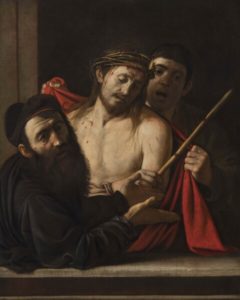How did a seemingly second-rate Old Master painting end up being declared a lost masterpiece set to go on display at the Prado Museum in Madrid?
In April 2021, a sale at Ansorena, a Madrid auction house, featured a seventeenth-century painting of Christ wearing the crown of thorns. This scene is often referred to as Ecce Homo, or “Behold the Man”, the words uttered by Pontius Pilate during Christ’s whipping and mocking. It was attributed to the circle of José de Ribera, one of the giants of Spanish Baroque painting known for his historical, biblical, and mythological works. Ansorena listed its opening bid as €1,500, or $1,780. However, shortly before the auction, the Spanish Cultural Ministry pulled it from the sale and slapped it with an export ban. This was after specialists in Spain and Italy suspected it was a lost work by the Italian Baroque master Michelangelo da Caravaggio.
Massimo Pulini, a professor at the Bologna Fine Arts Academy, claims that he was one of the first to identify Ecce Homo as a lost Caravaggio. “It was like meeting someone on the street who you haven’t seen for a long time. It’s difficult to explain what happens in certain moments when, in a millisecond, you have such an impression. It’s often a question of instinct.” Maria Cristina Terzaghi, an art historian at the Università Roma Tre, commented that the speed with which the scholarly community formed a consensus on the painting’s attribution as a Caravaggio was “absolutely unprecedented in the critical history of the painter”. Miguel Falomir, the Prado’s director, stated that new research indicates that Ecce Homo was likely created during the last years of the artist’s life, between 1607 and 1610. It was brought to Spain sometime in the seventeenth century, becoming part of King Philip IV’s collection. In the chaos of the Napoleonic Wars, during which France invaded Spain and suffered from a guerrilla war waged by the Spaniards, the painting found its way into the collection of Evaristo Pérez de Castro, a politician who later served as Spain’s Prime Minister between 1838 and 1840. His descendant, Antonio de Pérez de Castro, left the painting to his three children, who were the ones to consign the work to Ansorena.
The Prado Museum announced that the Pérez de Castro family has sold the work to an anonymous buyer for an undisclosed amount. Despite the secrecy, Ecce Homo is likely now worth tens of millions of dollars. The new owner also handed the Caravaggio over to the Colnaghi Gallery for full authentication and restoration since it was previously in poor condition. It was not only caked in grime, obscuring the colors, but a good amount of the paint had flaked off the canvas. The Prado currently has just one painting by Caravaggio in its collection, David with the Head of Goliath.
The new owner chose the Prado to display the now fully restored Caravaggio, which the museum will unveil on May 28th. Until then, Ecce Homo is being kept at the Colnaghi Gallery’s Madrid location. The Prado will exhibit the painting until October, after which it will stay in its collection for another few months before being returned to the owner.

